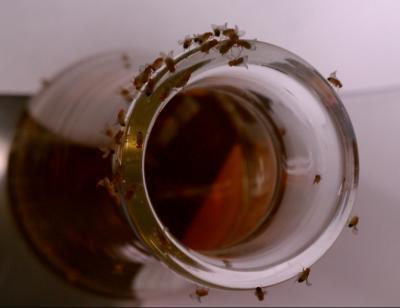Why do flies like beer? It's sweeter than you think. Entomologists say the flies sense glycerol, the sweet-tasting compound that yeasts make during fermentation.
The researchers examined the feeding preference of the common fruit fly for beer and other products of yeast fermentation, and found that a receptor - a protein that serves as a gatekeeper - called Gr64e is associated with neurons located in the fly's mouth is instrumental in signaling a good taste for beer.
Once a fly has settled on beer, Gr64e detects glycerol and transmits this information to the fly's neurons, which then influences the fly's behavioral response. Flies use other receptors in their sensory organs to find food from a distance.
"Insects use their taste system to glean important information about the quality and nutritive value of food sources," said Anupama Dahanukar, an assistant professor of entomology, whose lab conducted the research. "Sugars signal high nutritive value to flies, but little is known about which chemical cues flies use for food sources that are low in sugar content – such as beer."

Flies are attracted to beer because they detect glycerol, a sweet-tasting compound that yeasts make during fermentation. Credit: Dahanukar lab, UC Riverside.
"Taste becomes important only after the fly makes physical contact with food," she said. "A fly first locates food sources using its odor receptors – crucial for its long-range attraction to food. Then, after landing on food, the fly uses its taste system to sample the food for suitability in terms of nutrition and toxicity."
Dahanukar explained that taste receptors also come into play when a female fly has to locate a suitable site for laying eggs.
"Females come to a decision after they have conducted intense probing of various potential sites," she said. "How do you get information from the chemical environment to the brain – not just in flies but other insects as well? How is that information processed to give rise to appropriate behavior? How does feeding behavior change with hunger? These are some questions we would like pursue."
Zev Wisotsky, Adriana Medina, Erica Freeman&Anupama Dahanukar, 'Evolutionary differences in food preference rely on Gr64e, a receptor for glycerol', Nature Neuroscience (2011) doi:10.1038/nn.2944





Comments